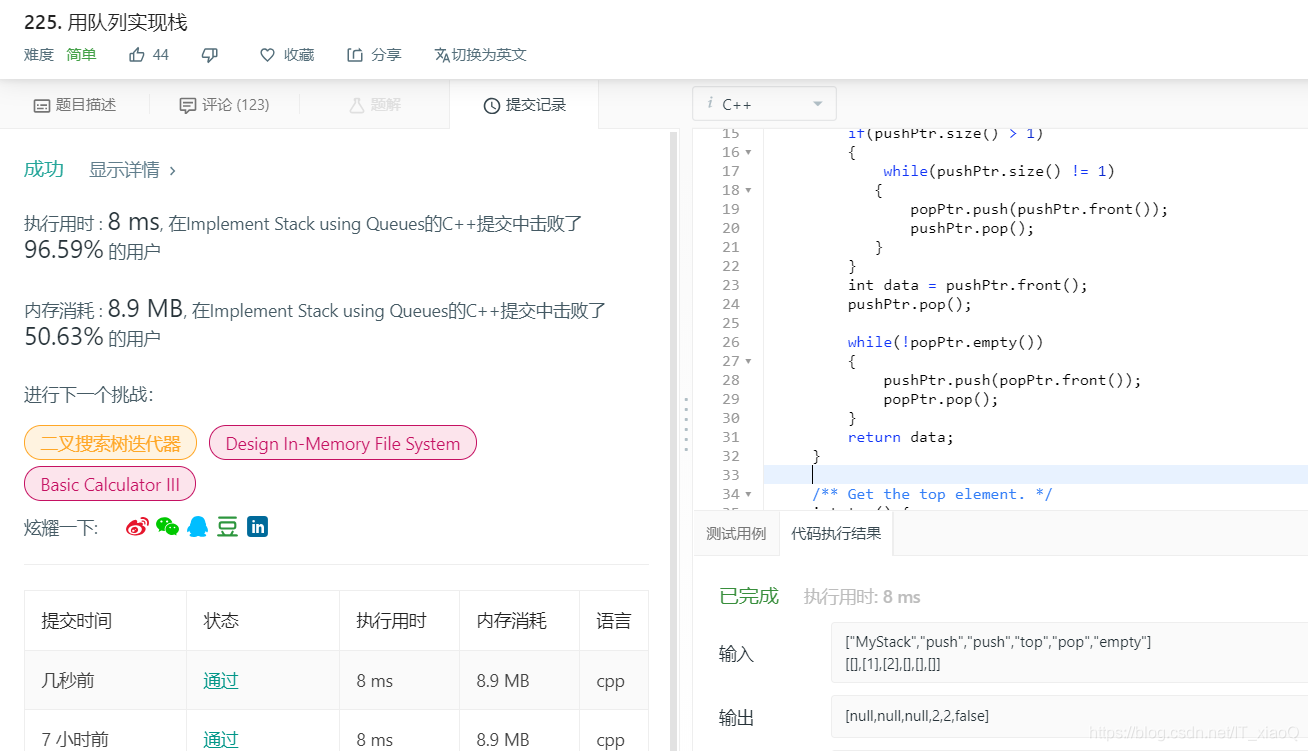题目描述:
使用队列实现栈的下列操作:
- push(x) -- 元素 x 入栈
- pop() -- 移除栈顶元素
- top() -- 获取栈顶元素
- empty() -- 返回栈是否为空
注意:
- 你只能使用队列的基本操作-- 也就是?
push to back,?peek/pop from front,?size, 和?is empty?这些操作是合法的。 - 你所使用的语言也许不支持队列。?你可以使用 list 或者 deque(双端队列)来模拟一个队列?, 只要是标准的队列操作即可。
- 你可以假设所有操作都是有效的(例如, 对一个空的栈不会调用 pop 或者 top 操作)。
解题思路:
在实现用队列实现栈时,不像用栈来实现队列那样每pop一个数据它只会搬移一次,只有在栈空时才将压得数据压过来。在队列实现栈时,每pop一个数据就会把整体所有元素进行搬移。
这次和栈实现队列不同的是,每次都是在源队列中pop,而不在借用的队列中pop,它只是临时搬移数据的容器。而栈实现队列时,是借用另一个栈来pop数据。
具体方法:
每当pop时,只留下最后一个数据,其它数据全部入另一个队列。然后pop掉源队列中的队首元素。再将原来的数据重新入源队列。这样每当pop时就重复上面操作。
代码实现:
class MyStack {
public:
/** Initialize your data structure here. */
MyStack() {
}
/** Push element x onto stack. */
void push(int x) {
pushPtr.push(x);
}
/** Removes the element on top of the stack and returns that element. */
int pop() {
if(pushPtr.size() > 1)
{
while(pushPtr.size() != 1)
{
popPtr.push(pushPtr.front());
pushPtr.pop();
}
}
int data = pushPtr.front();
pushPtr.pop();
while(!popPtr.empty())
{
pushPtr.push(popPtr.front());
popPtr.pop();
}
return data;
}
/** Get the top element. */
int top() {
return pushPtr.back();
}
/** Returns whether the stack is empty. */
bool empty() {
return pushPtr.empty();
}
queue<int> pushPtr;
queue<int> popPtr;
};
/**
* Your MyStack object will be instantiated and called as such:
* MyStack* obj = new MyStack();
* obj->push(x);
* int param_2 = obj->pop();
* int param_3 = obj->top();
* bool param_4 = obj->empty();
*/
运行结果:

? ? ? ? ? ? ? ? ? ? ? ? ? ? ? ? ? ? ? ? ? ? ? ? ? ? ? ? ? ? ? ? ? ? ? ? ? ? ? ? ? ? ? ? ? ? ? ? ? ? ? ? ? ? ? ? ? ? ? ? ? ? ? ? ? ? ? ? ? ? ? ? ? ? 珍&源码
cs


